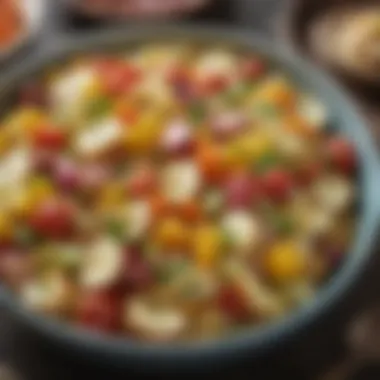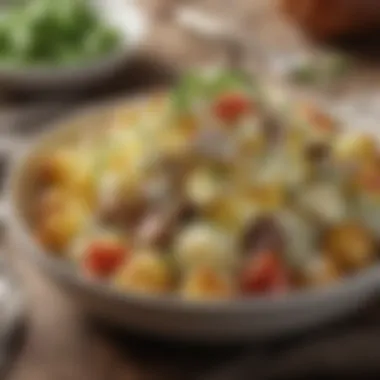Baked Potato Salad Recipe: A Comprehensive Exploration


Intro
In the realm of culinary delights, baked potato salad stands out as a harmonious blend of comfort and innovation. This dish beautifully marries the classic appeal of baked potatoes with the fresh, vibrant characteristics of a salad. There is a sense of creativity involved when combining these elements, leading to a satisfying and versatile meal suitable for various occasions.
Baked potato salad can serve as a side dish for a summer barbecue or as a light main course during a casual dinner. The key lies in selecting quality ingredients and employing techniques that elevate the dish. Potatoes are often the star of the plate; however, the accompanying elements such as creamy dressings, assorted herbs, and colorful vegetables play an essential role in creating a pleasing visual and flavorful experience.
This article will explore how to make a delectable baked potato salad by examining the ingredients, providing step-by-step instructions, and discussing possible variations. It will serve as a comprehensive guide for anyone looking to enhance their culinary skills and enjoy a dish that offers both comfort and flair.
Understanding the nuances of this recipe can lead to a greater appreciation for the dish itself, making it not just food, but an experience to savor.
Prelude to Baked Potato Salad
Baked potato salad is not just about combining potatoes with other ingredients. It is a dish that holds a special place in many culinary traditions. The blend of warm baked potatoes with various flavors creates a comforting and satisfying meal option. Understanding its significance helps people to appreciate the dish's versatility. This article will explore the key components, preparation steps, and different variations of baked potato salad. Readers will gain insights into its origins and the reasons behind choosing baked potatoes over traditional boiled ones.
The Origin of Potato Salads
Potato salads have been around for centuries, with roots in different cultures. The earliest versions likely come from Europe, where potatoes were first cultivated. Over time, various ingredients were incorporated to enhance flavor and texture. For example, the classic German potato salad introduced vinegar and bacon, offering a tangy, savory experience. Different countries adapted the concept, leading to a wide array of recipes worldwide. Understanding these origins can deepen appreciation for baked potato salad’s evolution and cultural relevance.
Why Baked Potatoes?
Choosing baked potatoes for salad adds a unique element that sets this dish apart. Baked potatoes maintain their structure better than boiled ones. Their dense texture allows for a satisfying mouthfeel. Moreover, baking brings out the potatoes' natural sweetness and nutty flavors. This method traps moisture inside, leading to a creamy interior that contrasts well with crunchy add-ins, such as vegetables or nuts. The appeal of baked potato salad lies in its combination of textures and flavors, providing an enjoyable culinary experience.
Key Ingredients
Key ingredients are the backbone of any recipe, and for baked potato salad, they play a crucial role in determining the flavor, texture, and overall experience of the dish. In creating a baked potato salad that stands out, understanding the components that make it unique is essential. The right combination of ingredients not only enhances the taste but also aligns with dietary preferences and nutritional goals. Each ingredient has a specific contribution to the dish, allowing for a myriad of variations to suit different palates and occasions.
Selecting Potatoes
The type of potato used can significantly influence the outcome of your baked potato salad. Starchy potatoes like Russets or buttery Yukon Golds are often the best choices because they bake well and provide a fluffy interior. These types absorb dressings and flavors more effectively. Choosing the right potato is a matter of texture and flavor. With proper baking, they achieve a nice crisp skin, while the insides remain soft and easily mixable with other ingredients.
Essential Add-Ins
Adding in various components can elevate your baked potato salad. The selection of essential add-ins is vital for depth of flavor and nutrition.
Herbs and Spices
Including herbs and spices is critical for enhancing the flavor profile of the salad. Ingredients like dill, chives, or parsley can provide a fresh, vibrant note. Their ability to complement the potato's natural flavor makes them a popular choice. For example, fresh dill brings a bright and slightly tangy character to the dish, making it ideal for balancing richer ingredients. However, it's crucial to use them judiciously; too much can overpower the salad's intended taste.
Vegetables
Vegetables are another essential add-in that contributes both flavor and crunch to baked potato salad. Ingredients such as bell peppers, green onions, or celery add texture and color. Bell peppers, for instance, provide a sweet crunch that contrasts well with the creaminess of the potatoes. Their vibrant colors also enhance the visual appeal, making the dish more inviting. However, some vegetables may release moisture, which can affect the overall consistency of the salad. It's important to keep this in mind when selecting your vegetables.
Proteins
Incorporating proteins not only increases the nutritional value but also adds a satisfying element to the salad. Options like bacon, cooked chicken, or hard-boiled eggs can make the dish more filling. Bacon, for example, contributes a smoky flavor that pairs beautifully with the potatoes. When choosing proteins, consider how they enhance the overall dish without overpowering the other flavors.
Dressing Variations


The dressing serves as the final touch that marries all the ingredients together. Varying the dressing can significantly alter the salad's profile. Classic options include mayonnaise-based dressings, yogurt-based alternatives for a lighter touch, or vinaigrettes for a tangy finish. Each dressing has its unique flavor nuances and may cater to different dietary needs. Experimenting with various dressings can lead to delightful discoveries and personal preferences.
Preparation Steps
Preparation steps are a critical part of making baked potato salad. They can significantly impact the final product's flavor, texture, and overall presentation. Understanding these steps allows for better control over the quality of each ingredient, ensuring a harmonious blend that elevates the dish. Attention to detail during preparation can make the difference between an ordinary salad and a memorable one.
Baking the Potatoes
In any baked potato salad, the way you bake the potatoes is crucial. The baking process greatly influences the outcome of both the flavor and the texture of the potatoes themselves.
Timing and Temperature
The timing and temperature for baking potatoes is paramount. Typically, baking potatoes at 400°F for about 45 minutes yields the best results. This method ensures that the potatoes cook evenly, forming a crispy skin while maintaining a fluffy interior.
A key characteristic of this baking temperature is its efficiency. Higher temperatures allow for the skin to crisp up, enhancing both flavor and texture. This is a beneficial choice because a crisp outer layer contributes a delightful contrast when combined with softer elements in the salad.
However, it is essential to monitor the time closely. Overbaking can lead to dryness, which will affect the overall taste. On the flip side, underbaking will not yield the desired texture and can result in a gooey consistency, ruining the salad.
Achieving the Perfect Texture
Achieving the perfect texture of baked potatoes is what sets a great baked potato salad apart from the rest. The ideal potato should be dense yet tender. When you achieve this, it allows the potatoes to hold their shape during mixing, providing a pleasant mouthfeel.
A critical element in achieving this texture is the choice of potato. Varieties such as Russet or Yukon Gold are ideal due to their starch content which contributes to a fluffier consistency inside. Their unique characteristic is that they bake well and absorb flavors from other ingredients easily.
This step is beneficial as it lays the foundation for the salad’s overall quality. It allows for maximum flavor integration when combined with herbs, spices, and dressings. Failure in this aspect may lead to a mushy or grainy texture, negatively impacting the dish.
Preparing Additional Ingredients
While the potatoes are baking, it's crucial to prepare additional ingredients. This step includes chopping vegetables, measuring out spices, and preparing any proteins that may be added. Doing this concurrently ensures that when the potatoes are ready, everything is set to be mixed promptly.
In this exploration, fresh ingredients such as green onions and bell peppers can add color and crunch, greatly enhancing the visual appeal and palatability of the salad. It's important to keep texture in mind when selecting these ingredients. They should provide a contrast to the soft potatoes, keeping the dish interesting.
Combining Flavors
Combining flavors is where the true artistry of baked potato salad happens. Careful attention during this phase ensures the final dish is balanced and flavorful.
Tossing Techniques
The technique used for tossing the ingredients is crucial. A gentle folding method can help maintain the integrity of the potatoes while ensuring even distribution of flavors. This is vital for any salad, as it prevents the potatoes from breaking down too much.
A characteristic benefit of this technique is that it preserves the texture, making sure each mouthful has a bit of everything. On the downside, if stirred too vigorously, the potatoes can become mushy, leading to an unappealing consistency in the final dish.
Balancing Seasoning
Balancing seasoning is just as important as any other step in the journey of this salad. Seasoning should enhance, not overpower. For baked potato salad, a combination of salt, pepper, and perhaps a splash of vinegar or lemon juice can highlight the natural flavors.
The unique feature of this balancing act is that it allows the ingredients’ individual characteristics to shine through while still merging into a cohesive flavor profile. Achieving this balance is beneficial because it results in a more enjoyable eating experience. However, it requires practice and adjustments according to personal taste.


"Preparation is the foundation of a great dish; every element must be considered carefully, especially when it comes to flavor and texture."
Serving Suggestions
Serving suggestions play a vital role in creating an enjoyable dining experience. They not only enhance the visual appeal of the dish but also contribute to the overall perception of flavor and satisfaction. A well-presented baked potato salad can elevate simple ingredients into a remarkable culinary experience. Therefore, understanding how to effectively present and pair baked potato salad becomes essential for any food lover.
Presentation Ideas
The presentation of baked potato salad can significantly impact its reception. Attractiveness can entice diners before they even take a bite. When arranging your salad, consider the following techniques:
- Choose the right dishware: A large, shallow bowl helps showcase the salad’s colorful components. Alternatively, individual servings in small bowls can create a charming, intimate setting.
- Layer ingredients: Instead of simply mixing everything together, try layering potatoes, vegetables, and dressing. This not only adds dimensions but also allows diners to appreciate the distinct flavors present in each layer.
- Garnish creatively: Fresh herbs like chives or parsley not only enhance flavor but also add a burst of color. You can also sprinkle some paprika or a bit of freshly cracked black pepper for an added touch.
- Serve chilled or slightly warm: Depending on the season, consider the serving temperature. A chilled salad can be refreshing in summer, while a warm salad can evoke comfort in winter.
Each of these strategies can enhance the dish's overall aesthetic, making it appealing to the eye. Incorporating a few garnishing elements or serving it creatively can create a lasting impression on your guests.
Ideal Pairings
Pairing baked potato salad with complementary dishes can elevate your meal. The following options can work well:
- Grilled meats: The creaminess of the potato salad pairs nicely with grilled chicken or steaks, providing a textural contrast that is satisfying.
- Fresh salads: A crisp green salad can balance the richness of the baked potato salad, refreshing the palate with each bite.
- Bread options: A side of warm garlic bread or crusty rolls complements the dish while also providing a delightful vehicle for finishing off every last bit of salad.
- Wine selections: If you prefer beverages, consider serving a light white wine, such as Sauvignon Blanc, which can enhance and uplift the salad's flavors.
These pairings not only complete the meal but also fend off the tendency for a dish to feel isolated in terms of flavor profile. Finding the right complimentary items can transform a simple dish into a delightful culinary ensemble.
Nutritional Considerations
When it comes to baked potato salad, the nutritional aspects are essential. This dish can be a delightful indulgence, but understanding its components can help maximize health benefits. The balance of ingredients in this salad can serve various dietary needs and preferences, making it versatile for many occasions. A focus on nutritional considerations can elevate not only the dish but also the overall dining experience.
Caloric Breakdown
The caloric makeup of baked potato salad primarily comes from its key ingredient: the potato. A medium-sized baked potato contains around 160 calories. The total caloric content can increase significantly depending on the add-ins and dressings used. For instance, incorporating creamy dressings or high-fat ingredients such as cheese can raise the calorie count. Conversely, utilizing healthier options like yogurt or vinaigrettes can help maintain a lower caloric level. Understanding these elements allows for better planning, whether it's for a light meal or a more indulgent treat.
Health Benefits of Potatoes
Potatoes are more than just a filler in this salad. They are an excellent source of vitamins and minerals, most notably Vitamin C, potassium, and Vitamin B6. These nutrients contribute positively to immune function, heart health, and overall energy levels. Additionally, potatoes are a source of fiber, especially with the skin on, which can aid digestion and promote a feeling of fullness. Their complex carbohydrates provide sustained energy, making them a valuable part of a balanced diet.
Dietary Modifications
Vegan Options
For those following a vegan diet, baked potato salad can easily adapt to meet these needs. These options often involve substituting traditional dairy-based dressings with plant-based alternatives or simply using olive oil and vinegar. This not only makes the dish vegan-friendly but often adds fresh, vibrant flavors. The key characteristic of vegan options in this context is their reliance on whole, unprocessed ingredients. Thus, they can be a nutritious choice, maintaining the essence of the dish while excluding animal products.
Low-Carb Alternatives
Some individuals may prefer low-carb alternatives due to dietary restrictions or personal preferences. Instead of traditional potatoes, options like cauliflower can serve as a great substitute. Cauliflower maintains a similar texture when baked and provides a unique flavor. The key characteristic of low-carb alternatives lies in their lower caloric density, making them appealing for those watching their carbohydrate intake. However, substituting can alter the traditional flavors associated with potato salad, presenting both advantages and disadvantages for the discerning palate.
Innovative Variations
Innovative variations in baked potato salad are more than mere enhancements; they represent a gateway to diverse culinary experiences. By infusing different cultural influences and seasonal ingredients into this dish, cooks can elevate the standard recipe, providing a fresh take that satisfies various tastes and preferences. This article explores such variations, emphasizing their importance in maintaining the relevance of baked potato salad in both casual and formal dining settings.


Global Influences
Latin American Touch
The Latin American touch introduces vibrant flavors and unique ingredients that can transform the baked potato salad into a zesty dish. Utilizing ingredients such as avocado, cilantro, and lime juice creates a refreshing blend that stands in contrast to the traditional creamy versions. This approach not only brightens the aesthetic appeal of the salad but also enhances its flavor profile, making it more interactive and engaging for the palate. One key characteristic of this style is the emphasis on fresh, lively tastes.
- Pros:
- Cons:
- Adds a refreshing and vibrant dimension to the dish.
- Incorporating ingredients like avocado enhances nutritional value with healthy fats.
- The distinct flavors may not appeal to everyone, especially those desiring classic tastes.
- Ingredients such as lime may create acidity that overshadows more subtle flavors.
Asian Inspirations
Asian inspirations offer a different perspective by integrating flavors that are often bold yet balanced. Ingredients such as ginger, sesame oil, and green onions can introduce an aromatic complexity to baked potato salad. This unique feature contributes to a diverse gastronomic experience, capturing the essence of multiple culinary traditions. The use of soy sauce can further deepen the flavor, adding umami to the dish.
- Pros:
- Cons:
- Fresh herbs and spices like cilantro can elevate the freshness.
- Nutritional components from vegetables can add crunch and texture, creating a pleasing mouthfeel.
- Flavors can be polarizing; some may find the combinations too unconventional.
- Ingredients might require careful balancing to avoid overwhelming the potatoes.
Seasonal Ingredients
Summer Flavors
Summer flavors shine through the use of fresh, seasonal ingredients that evoke warmth and abundance. Incorporating items like corn, bell peppers, and fresh herbs can celebrate the season’s harvest. This characteristic makes it a lively choice for summer barbeques or picnics, where light and fresh dishes are more desirable. The unique feature of these ingredients is their ability to complement the richness of baked potatoes while maintaining a refreshing vibe.
- Pros:
- Cons:
- Brings a lightness to the dish, making it suitable for warm weather meals.
- Encourages the use of local produce, enhancing sustainability.
- Seasonal dependence can limit availability of certain flavors in off-peak times.
- May not have the same comfort appeal as heartier winter options.
Winter Comforts
In contrast, winter comforts focus on heartiness and warmth, utilizing ingredients that provide a sense of cozy satisfaction. Adding components like bacon, cheese, and sour cream can create a richer experience that resonates with the essence of comfort food. The key characteristic of winter variations lies in their ability to offer a satisfying dish that warms from the inside out.
- Pros:
- Cons:
- Great for gatherings, creating a filling option for colder months.
- Ingredients rich in flavors provide depth and comfort.
- May veer away from the lighter salad profile desired in summer.
- Health-conscious eaters might find these variations less appealing.
Exploring innovative variations in baked potato salad can not only enhance the dish's appeal but also broaden one's culinary skills, making it easier to adapt to different tastes and occasions.
These innovative approaches provide useful insights into how simple ingredients can be transformed into diverse flavors that retain the essence of baked potato salad while ensuring it remains a popular choice all year round.
Epilogue
The conclusion of this article provides a vital opportunity to assess the multifaceted aspects of baked potato salad. By summarizing key elements introduced earlier, it reinforces the importance of this dish in culinary exploration. Baked potato salad serves not merely as a side dish but as a canvas for creativity, understanding flavor dynamics, and nutritional awareness.
Summary of Key Points
- Origin and Purpose: The exploration began with a brief history of potato salads, emphasizing how baked potatoes introduce a unique texture and flavor profile. The baked component adds depth, transforming a simple combination of ingredients into something substantially more appealing.
- Key Ingredients: Identifying quality ingredients is crucial. From the right type of potatoes to the essential add-ins, each component plays a role in crafting a balanced dish. Selecting fresh herbs, crisp vegetables, and quality proteins can significantly enhance the overall experience.
- Preparation and Techniques: The steps involved in baking, preparing additional ingredients, and combining flavors are essential. Knowing proper timings and techniques can make a considerable difference in the final product.
- Nutritional Considerations: The significance of caloric breakdown, health benefits, and possible dietary modifications was covered. Understanding how to maintain a nutritious balance while enjoying this dish is imperative for many.
- Innovative Variations: Global influences and seasonal ingredients were highlighted, offering a scope for creativity. This versatility allows individuals to adapt the recipe for various cultural inspirations and seasonal ingredients.















